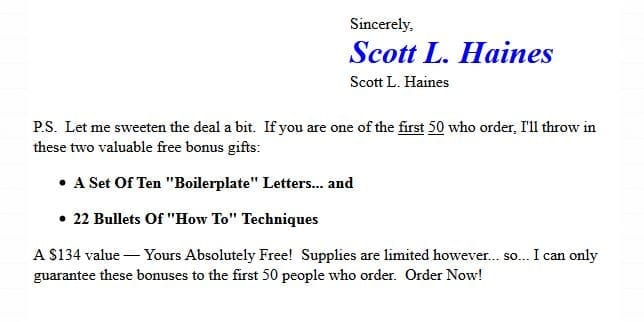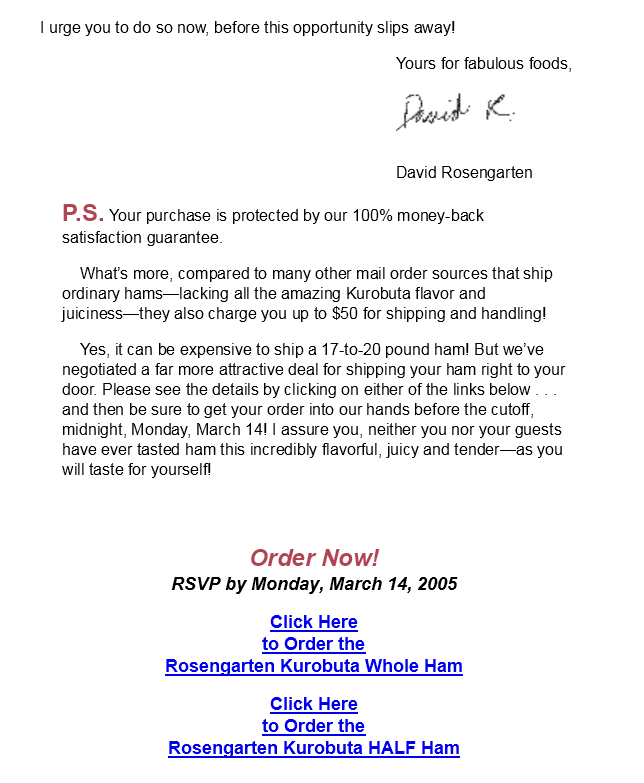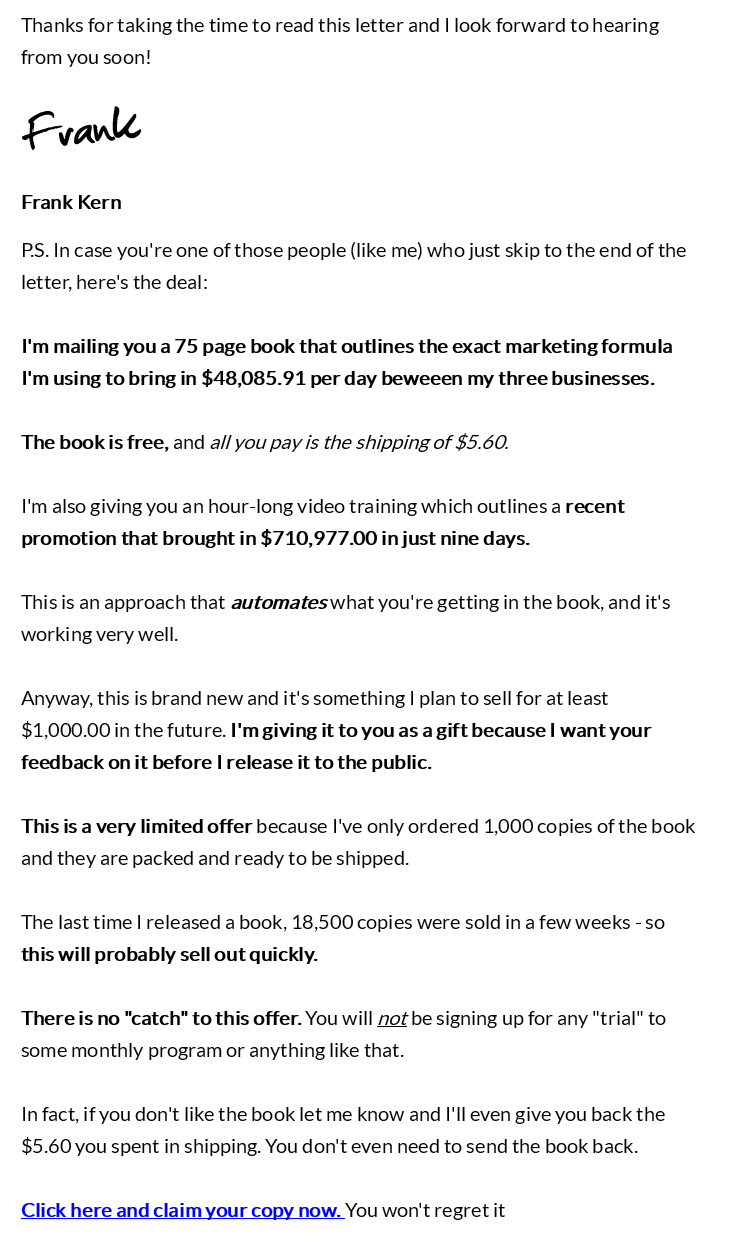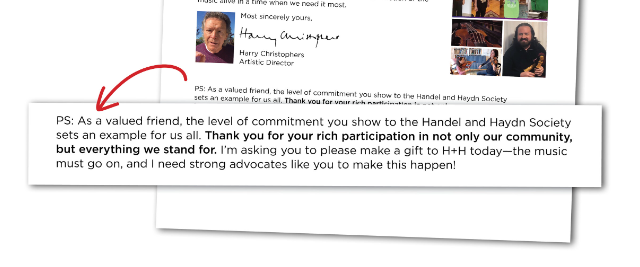P.S. Is Not Dead - Learn How To Use This Powerful Tool to Make Your Reader Take Action
It used to be an afterthought.
In the times of handwritten and typewritten letters, it was impossible to edit, delete, or add new information without making a mess.
If you wanted to keep things clear and neat, your best option was to add a postscript. You wrote P.S. and make the correction there, or add something you forgot to tell.
Now that you can edit, delete, and add whatever you want without a problem, you might think a postscript is useless.
It turns out a P.S. is a powerful copywriting and marketing tool.
It is your last chance to get your reader to take action and your last opportunity to convert your prospect into a new customer.
Let's see how and where to use it to make the most of it. But first...
Who says a P.S. is so important?
I don’t know about you, but I like knowing where things come from.
When talking about the importance of the PS, people often mention two percentages:
- "Over 90% of readers read the PS before the letter. It is the first paragraph, not the last."
- "79 percent of people who opened a direct mail letter would read the PS first."
The first one comes from Siegfried Vögele, author of Handbook Of Direct Mail: The Dialogue Method Of Direct Communication (1992).
Vögele was the first to analyze how people read and interact with the letters they received. He found out that 90% of readers read the PS before the letter, and they read it word for word.
He called the path they follow "the reading curve." It goes something like this:
- People check who is writing to them.
- Then, look for their own name and the salutation.
- Skip to the end to see who signed the letter.
- Read the P.S.
- Decide whether or not to read the letter from the beginning.
The second percentage comes from Kate Goldstone. During her time working in financial services, they did several A/B testing experiments that revealed how 79% of people who opened a direct mail pack read the postscript first, before reading anything else.
They also noticed how adding a P.S. often leads to a boost in conversion rates.
Apart from these two references, we have what well-known marketers and copywriters have to say:
“A strong P.S. does not beg, but rather invites the reader to take the final step before purchasing. It’s a strong and clear statement that contains the final call to action.” -Michael Fortin
“By properly summarizing the offer/promise in your PS, you can inspire the recipient to dig in and read the entire letter, or simply add an extra incentive to respond." -Dan Kennedy
“The PS in a letter is often the most-read line of type on the page. So either offer something in the PS that causes the reader to solidify a buying decision or reiterate a very important point.” - Joe Sugarman
Now that you know how important the P.S. is, let’s see where and how to use it.
Where to use the P.S.
Mostly on sales letters and emails.
The P.S. is the second most read part of a sales letter. After reading the headline the majority will jump to the bottom.
The same goes for emails. People read the subject line to decide if they open it or not. Then comes a quick skim, the signature, and the P.S.
And speaking of emails, let me point out that a recent Litmus study indicates a decline in the time readers spend engaging with emails, from 13.4 seconds in 2018 to 9 in 2022. With so little time, make sure your P.S. counts.
Do you have to include a P.S. at the end of every sales letter or email? Not really. Use it when it fits the content you're sending (You'll see different uses below.)
How long it should be? The PS tends to be short in emails (a couple of sentences) but it can be quite long in sales letters. I have seen P.S. that could be defined as mini-sales letters.
How to use the P.S.
Here are some possible uses:
- Provide a brief summary of the letter or the email content and reiterate its main purpose.
- Restate any of its key points (the big idea, the promise, the major benefits, or the call to action.)
- Recap your offer. Tell what includes, list important benefits, and outline the extras you are offering.
- Restate something important you have expressed in your headline or subject line.
- Mention an additional bonus.
- Disclose some benefit, important information, or intriguing fact that you have “forgotten” to include in your copy.
- Create a sense of urgency.
- Add social proof. Include testimonials, mention customer stories, case studies, or direct quotes.
- For fundraising, make a final plea for a donation.
- Use it to tell something interesting, surprising, or funny.
You can include more than one postscript in your sales letters and emails. It’s a great way of combining some of the uses from the above list.
If you include more than one, then make it a triad of P.S.’s. According to Michael Fortin, split testing has shown that when you have three, your readers tend to read and respond to the one in the middle. Use that one to highlight what you want your readers to pay attention to.
Let's see some examples of the different ways you can use this powerful little thing.
The following P.S. comes from a sales letter written by Scott Haines. He attended Gary Halbert's seminar "How To Write A Sales Letter That Will Make You Rich" (1996) and wrote this letter to sell the seminar's transcript.
The P.S. is used for two things:
- To sweeten the deal by offering two valuable bonuses for free.
- To get the reader to take action right now by using scarcity (the bonuses are for the first 50 people who order.)

"The Greatest Ham I've Ever Tasted" is a sales letter, written by Gary Bencivenga, devoted to selling Kurobuta ham. The P.S. is used to remind the readers they are protected by a 100% money-back guarantee.
It promises an attractive shipping deal and creates a sense of urgency by reminding the reader there's a deadline to place your order, March 14th.

"Free Book Reveals How To Create Internet Campaigns That Sell" is a sales letter written by Frank Kern. The interesting thing about this PS is that you can make a purchase decision just by reading it. It tells you what the offer is, the shipping cost, the scarcity, the guarantee, and the call to action.

“Case For Gold” is a sales page from Agora Financial. In this case, the PS is used as an afterthought. The important piece of information the copywriter "forgot" is a gift to sweeten the deal.

"Get the ULTIMATE Marketing Shortcut… …FOR JUST $1" sales letter from Ryan Deiss. The PS is used first to create a sense of urgency and then for social proof. The second PS includes several Facebook comments used as testimonials.

Another example of PS used to include testimonials. In this case is from an email from copywriter Michal Eisikowiz. The testimonials reinforce the value of the offer.

And the last one. It's a PS from a fundraising asking for a donation and thanking them for their participation.

